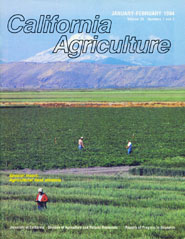


University of California
California Agriculture
|
|||
|
|||

Special insert: Agricultural field stations
Cover:
Special insert: Agricultural field stations
January-February 1984
Volume 38, Number 1 News and opinion |
|||
|
University of California, 1301 S. 46th St., Bldg. 478 Richmond, CA
|